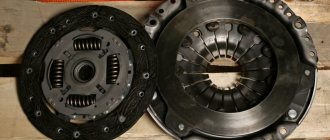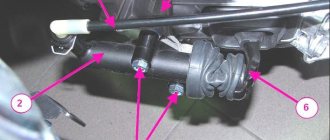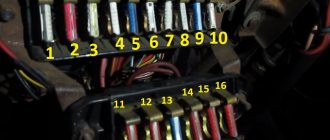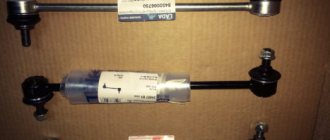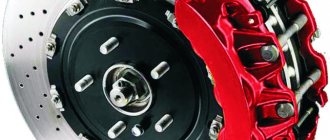In mid-2021, AvtoVAZ officially abandoned the use of manual transmissions from the French manufacturer Renault. The reason is the high cost of the “product” and the lack of a base for maintenance.
If domestic gearboxes cost 20–25 thousand rubles, then imported ones reached 45–50 thousand. Obviously, such a rise in price automatically increased the cost of the car as a whole. Perhaps because of this factor, many car enthusiasts preferred a model with a classic automatic or robotic option.
However, there are those who claim that the quality of production of domestic new mechanics (21087) is inadequate. They are ready to pay an additional 30,000 rubles for the French version. Let's compare the Renault JH3 (JR5) manual transmission and the VAZ 21087 manual transmission.
Specifications
| Name | Renault JH3 (JR5) | Manual transmission - 21087 |
| type of drive | Wire rope | |
| Number of speeds | 5 | |
| Main couple | 3,9 | |
| Gear ratio | 3,87 | 3,94 |
| Acceleration to “hundreds” | 11,2 | 10,2 |
| Maximum speed (km/h) | 175 | 188 |
| Fuel consumption (l/100 km) | 6,9 | 7,5 |
| Gear ratios for each gear | 3,636; 1,950; 1,357; 0,941; 0,784 | 3,727; 2,048; 1,393; 1,029; 0,795 |
Installing a shorter main pair increased the dynamics of acceleration, taking one second from the French “brand”. Adjusting the gear ratios for each gear made the transitions to higher gears smoother, without jerking, and dynamic.
Manual transmission options on Vesta
When developing this car model, the use of the “native” gearbox, the VAZ 2180, was initially envisaged. However, the former director of AvtoVAZ, Bo Andersson, rejected it due to the hum that occurs when the gears rotate and interact. Instead of the originally planned gearbox, a Renault JH3 manual was installed.
After carrying out the necessary work on the domestic gearbox, the designers managed to reduce noise and also create a more balanced gear shift pattern. After the improvements have been made on the Lada Vesta, the manual gearbox is again installed domestically. It is marked as VAZ 21087.
The new transmission has slightly different characteristics. The gear ratio is 3.94. The car can be accelerated to hundreds in 10.2 seconds, and the top speed has increased to 188 km/m. At the same time, the volume of fuel consumed has also increased slightly. Now it is 7.5 liters per 100 km. in a mixed driving cycle.
In general, the updated mechanics are characterized by reduced noise levels and increased service life due to the improved quality of the parts and materials used. To find out which gearbox is installed on the car, you need to look at the VIN number. The VAZ box is designated with the code GFL11, and the “renault” box with the code GFL13.
Design and diagram of manual transmission on Lada Vesta
| Name | Data |
| Type | Mechanics |
| Factory index (article) | 21087 |
| Drive unit | Front |
| Engine capacity | 1,8 |
| Torque | 170 Nm |
| Default oil type | ZIC GFT 75W-85 |
| Oil volume | 2,2 |
| Lubricant replacement | Every 75,000 km |
| Filter update | Likewise |
| Average service life before major overhaul | 180000 km |
| Compatibility | Lada Vesta, X-RAY with engine capacity 1.6 / 106 hp., 1.8 / 122 hp. |
Transmission operation diagram
To find out the type of transmission of your car, look at the VIN code:
- GFL11: mechanics;
- GFL12 - AMT box;
- GFL13 ─ mechanics from Renault.
About gearbox oil for Lada Vesta
According to the operating manual and technical regulations, Vesta’s robotic gearbox does not require an oil change, since it is designed for the entire service life of the unit. The same cannot be said about a manual transmission - the oil needs to be changed at least once every five years or after 75 thousand kilometers. There would be no need to change the factory oil if it were of decent quality. This is confirmed by many car owners who prefer to play it safe and change the lubricant as soon as possible after purchasing a car. The used lubricant does not have the best properties - it would hardly be enough for 75 thousand km without damaging the gearbox.
It is better to change the factory oil before 5 thousand km. Car owners note that the hum characteristic of this gearbox practically disappears, and gears are engaged more easily.
Oil brand
The manufacturer fills the Lada Vesta gearbox with TM-4-12 SAE 76W-85 GL-4 oil. This is a semi-synthetic all-season lubricant with a number of additives that ensure operation of the gearbox in the temperature range from -45°C to +45°C. Oil volume is 2.2 liters. As an alternative, it is recommended to use the following types of gear lubricants:
- ZIC GFT 75W-85;
- TRANSELF NFJ 75W-80;
- Hochleistungs-Getriebeoil 75W-90.
It is unacceptable to pour any transmission oil into the box, as this can lead to premature wear of parts. For this reason, you should not rely on a higher class lubricant - this does not mean that it is better suited for the Lada Vesta.
Lubricant replacement
The lubricant replacement process involves draining the old oil and adding new oil. To work you will need:
- wrenches, socket wrenches;
- flat screwdriver;
- container for used oil;
- hose and funnel.
It is recommended to drive 5 or 10 km before changing - this will allow the oil to drain better. The replacement process is as follows:
- the car is installed on a flat platform - above an inspection hole or on a lift;
- the engine protection is dismantled;
- the oil level plug in the gearbox is unscrewed;
- Place a suitable container under the drain plug and drain the oil;
- the drain plug is screwed back in;
- a hose with a funnel is installed in place of the control plug, and fresh oil is filled to the required level;
The control plug is screwed back in and the engine protection is put in place.
Oil can be filled through the reverse gear hole. It is located straight, and not at an angle, like the oil level plug, which means it will be more convenient to fill in the lubricant. Before pouring in new lubricant, you must carefully inspect the used one. If it is black, metal particles are visible in it - it is better to wash the box. To do this, instead of fresh oil, about 1.5 liters of flushing oil are poured. Then one front wheel is hung on a jack, and the second speed is turned on (with the engine running). After 5 minutes, the flush is drained and new transmission oil is added.
Car enthusiasts were unable to appreciate all the advantages of the robot, preferring the AMT classic “hand-held” version. The reason for the mistrust is explained very simply - the robot was created on the basis of domestic mechanics, which are known for not very high quality of assembly and components. It is almost impossible to change the negative attitude towards a box that has been known to several generations of car enthusiasts. The AvtoVAZ concern has already announced that a pure six-speed automatic transmission will be introduced in the near future. But there are no details yet about who will be involved in the development.
“Pros” and “cons” in comparison with an automatic machine (robot)
| Advantages | Flaws |
| Acceleration dynamics have become better, the car picks up speed faster | Increased fuel consumption in the combined cycle |
| The car is 30 - 35 thousand cheaper when purchased with a manual transmission | Crunching, creaking when driving at low speeds |
| Long service life | |
| Cheapness of spare parts and components | |
| The car is more expensive on the secondary market compared to the robotic version | |
Malfunctions and ways to eliminate them
| Malfunctions | Troubleshooting Methods |
| Transmission howl at 2000 – 3000 rpm | Insulation lining for gearbox control cables |
| Knock at idle | Replacing the pressure bearing |
| Critical wear of gears and teeth | Replacement with new ones, cannot be restored |
| Oil leaks from seals are less common. | Replacement of sealing seals with new ones. Overhaul of gearbox |
Service life - from the factory and actual
The manufacturer in the operating instructions indicates an average interval of 180,000 km before major repairs. In fact, the mechanics last up to 200,000 km, provided that the manufacturer’s recommendations for care and maintenance are followed.
At the stage of using mechanics, breakdowns associated with depressurization of the system, oil leakage, and wear of the pressure bearing are most often recorded. Malfunctions are insignificant, not critical, and can be eliminated in a few hours of work by technicians at a service station.
Conclusion
The manual transmission under the factory code 21087 is a real technological breakthrough of domestic engineers. The transmission turned out to be not only more powerful, but also faster. At the same time, fuel consumption increased by 0.5 liters.
“Mechanics” has its advantages and disadvantages compared to the robotic version. Therefore, before purchasing, carefully analyze the technical characteristics of each type of gearbox.
From personal experience I will say the following:
- The mechanics are most adapted for active use on rough terrain.
- The robotic version, “automatic”, is mainly used for high-speed modes.
Domestic mechanics VAZ 21807 5st
As we already know, the kind author of this piece is the proud owner of a product of Avtovaz PJSC - Lada Vesta, with VIN number - XTAGFL110HY097210.
In many advertising brochures and materials circulating on networks such as the Internet, such as here, the following praises are written - “Is the new manual transmission of the VAZ 21807 quieter than the previous one? The answer is YES! Quieter, no hum. Consumers are happy. ".
I don’t know which hearing impaired consumers were surveyed, but, alas, in my case a miracle did not happen.
The complaints about the gearbox are as follows: 1) Howling from the gearbox, especially in 2nd gear. Explanation - the same howl from the VAZ gearboxes, which on the West is slightly smoothed out by better Shumka, a cable drive of the gearshift lever, and perhaps the design of the supports. The gearbox itself has not become an ounce quieter. No miracle happened.
Change the oil? Are you kidding? Changed at 2 thousand km, result = 0. And you can’t cure the mess of gearbox gear teeth with oil.
2) Fuzzy engagement of 2nd gear, with a crunching sound from the synchronizer. This problem takes its roots back in the Prior era, the gearbox is essentially a modified 2180, which was installed on the specified product twice. Alas, this is also here.
3) Well, the cherry on cake No. 1 is the slipping clutch when cold, when starting to move in 1st gear. At the same time, the whole car shakes like a “groove,” as they say on specialized forums. If you open and close the clutch disc, the shaking goes away.
There is even a wonderful instruction from AvtoVAZ in this regard (not a revocable company, like decent manufacturers! Namely, upon the owner’s request) - we read.
4) Cherry on cake No. 2 - specifically in my case, in neutral the box knocks either with the hydraulic release shaft or the input shaft, or rather its bearings. Here's my video of cats, you can clearly hear it from the 2nd minute, starting from the 2nd minute. Now this knocking is progressing a little, and in some situations the knocking is much louder. Please check it out -{amp}gt;
Since the end of 2021, AvtoVAZ has abandoned the use of the French manual transmission in Vesta and Xray cars in favor of a domestic, modernized gearbox with the VAZ 21807 index. Now the domestic unit is installed on the entire model.
Reviews
| № | Positive |
| 1. | Dmitry , 33 years old (drive2.ru): they can’t say anything bad about the mechanics, the gearbox works properly. The car is only a year old, I regularly undergo maintenance, I don’t drive, I drive carefully. |
| 2. | Vyacheslav Petrovich , 47 years old (prom.ua): in a year and a half I drove about 20,000 km, mileage is above average. Impressions of the new mechanics are only positive. There is something to compare with; before this there was the Lada Granta. Grantmakers understand what I'm talking about. |
| 3. | Alexander Alekseevich , 43 years old (drom.ru): after buying the car, I changed the transmission oil for the first time at the 7000 km mark. I didn’t wait for 75,000 km, as the manufacturer recommends. The waste was of a natural color, metal shavings were present, but their quantity was insignificant. I did the same. |
| 4. | Alexey Petrovich , 48 years old (rozetka.ua): I’ve heard numerous negative reviews about the mechanics, I can’t confirm. I believe that the technical condition and performance of the unit depends on the driver. I don’t have any problems with this, I take care of my equipment. |
| 5. | Semyon Vyacheslavovich , 40 years old (Auto.ru): This is the second year since I bought and actively use a Lada Vesta on the mechanics. The review is positive, there are no comments about the work. |
| 6. | Vasily Timofeevich , 43 years old (Auto.Mail.Ru): for a year and a half of using a car with mechanics, he once made an unscheduled visit to a service station for diagnostics. I was at fault for the hum in the manual transmission, but it was the suspension. I hope that the device reaches the 180,000 km specified by the manufacturer. |
| 7. | Dmitry Gennadievich , 41 years old (drive2.ru): I like the mechanics more than the robot, I drove the AMT for three months, I can compare. Both robot and automatic are not adapted for domestic roads. The units do not last long, so it is better to buy a manual transmission. |
| 8. | Sergey , 35 years old (drive2.ru): on the mechanics, as soon as I pressed the pedal, I pressed it. And overtaking, and maneuverability, without kickdowns, delays in switching. Choice: definitely mechanics. |
| Negative | |
| 9. | Dmitry Semenovich , 52 years old (prom.ua): no matter how hard we tried, a miracle did not work. We decided to save several tens of thousands, but for the wrong reasons. It would be better to make the plastic cheaper than to install a Russian gearbox instead of a French one. Knocking and noise in the manual transmission was detected at 40,000 km. With such a low mileage there are such significant defects. |
| 10. | Gennady , 46 years old (Bibika.ru): after 30,000 km, cases of clutch slipping, delays when changing to higher gears, and howling of the gearbox became more frequent. You need to go to a workshop and order diagnostics. Couldn’t it have been done better from the start? |
| 11. | Boris , 38 years old (drive2.ru): at 25,000 km a gearbox whine appeared on a Lada Vesta. The officials said that the pressure bearing needs to be changed, but this is not certain. The final diagnosis will be announced after a comprehensive diagnosis. |
| 12. | Sergey Gennadievich , 45 years old (Avtodispatcher.ru): a knock in the gearbox was detected already at 31,000 km. Initially the fault was with the suspension, but after diagnostics the technician assured me otherwise. |
Oil in manual transmission Lada Vesta
Taking into account the fact that the manual transmission version of the Lada Vesta remains the most common and in demand, next we will consider the issue of changing the oil on the manual transmission, as well as what is poured into the Vesta box from the factory.
First of all, although the manufacturer claims that this gearbox is maintenance-free and is designed for the entire service life of the car, many car enthusiasts claim that the oil filled at the factory is far from the best quality. When replacing, there is often a significant loss and deterioration in mining properties after 40-60 thousand km. mileage It turns out that with long-term use of such oil without replacement, a reduction in service life and other problems are inevitable.
Of course, this is not the official opinion of experienced experts; special separate tests have not been carried out either, but the fact remains a fact. Let us also add that those owners who have changed the oil in a Lada Vesta manual transmission often note improvements in the operation of the unit, gear shifts become softer and clearer, the gearbox operates less noisily, the lubricant does not thicken so much in cold weather, etc.
At the factory, the Vesta box is filled with TM-4-12 SAE 76W-85 GL-4 oil. This product is semi-synthetic, designed for year-round use (all-season gear oil). This oil also contains a package of imported additives and is designed to operate at temperatures from -40 to +45 degrees Celsius. The total oil volume in the Lada Vesta gearbox is 2.2 liters.
As for changing the oil, you can either try to purchase exactly the same fluid or choose other analogues
It is important to take into account a number of features. Many experts recommend using semi-synthetic ZIC G-FF 75W-85 in the Lada Vesta transmission
You can also pay attention to fully synthetic oils
For example, ZIC GFT 75W-85. This is PAO synthetics (based on polyalphaolefins). For the wave, you can consider Motul and Liqui Moly gear oils (for example, LM Getriebeoil 75W-90). The main thing is to select a lubricant so that it fully complies with the tolerances and recommendations of the gearbox manufacturer.
Otherwise, “inappropriate” oil can lead to problems with the gearbox, failure of individual elements, increased wear and damage to synchronizers, etc. For reference, if the manufacturer specifies that only GL-4 oils should be poured into the gearbox, the use of higher class oils such as GL-5 can cause rapid failure of the gearbox synchronizers.
How to change the oil in a Lada Vesta gearbox
Having figured out what kind of oil the factory pours into the Vesta manual transmission, as well as how to select analogues for replacement, let’s move on to replacing the transmission fluid itself. In order to change the oil in the Vesta gearbox or Lada Vesta AMT (robotic automated mechanics), you need to prepare:
- necessary keys;
- slotted screwdriver;
- container for draining waste (up to 3 liters);
- rags (clean rags);
- hose with a diameter of 20 mm and a funnel;
- 4-6 liters of fresh oil (with reserve for topping up or flushing);
The main task is to drain the old oil as completely as possible and fill in new fluid according to the level. In order for the waste to drain out of the box better, the gearbox must be pre-warmed by driving about 10 km in active mode before draining the old oil.
The oil change itself in the Lada Vesta gearbox comes down to the following:
- lift the car on a lift or drive it into a viewing hole;
- the car must be positioned level, without slopes;
- remove the engine protection;
- Next, you will need to unscrew the oil level control plug in the gearbox;
- then you should find the drain plug and place a prepared container under it to drain the waste;
- then you need to unscrew the drain plug with a 8mm square wrench and wait until the transmission fluid completely drains into the container;
- after complete drainage, the drain plug should be screwed in; if necessary, the seal can be replaced;
- Now a hose with a funnel is inserted into the control hole, after which fresh oil is carefully poured in small portions;
- when the level rises to the edge of the hole, the replacement can be considered complete;
- Now the inspection hole plug can be tightened and the engine protection can be put in place.
